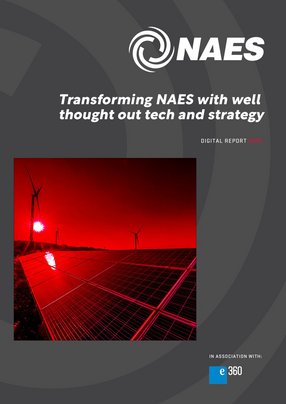Transforming NAES with well thought out tech and strategy
Transforming our lives in ways we wouldn’t have thought possible decades ago, digital technologies are driving forward business and improving our daily lives. The energy sector is going through an unprecedented era of digital transformation as the industry looks for new ways to improve efficiency and safety – with technology being crucial in the bid to tackle climate change and facilitate the push for renewable energy.
Keen to be part of this transition to the digitally-empowered energy sector, NAES Corporation is dedicated to optimising the performance of energy facilities across the power generation landscape.
“NAES is quite diversified,” says Mark Holtermann, Vice President, IT and Digitisation at NAES.
“There are three primary industries we operate in: energy, construction and fabrication. We offer a variety of services including operating and maintaining over 200 power plants across the US as well as Mexico, and even in the UK. It’s over 100,000MW of power that we are essentially managing for other owners. Those plants could be utilities, private owners, or consolidated groups of owners.
“We provide operations and maintenance services, asset management, grid management, compliance, fleet services, consulting services in the energy space, along with a list of other services.
“On the construction fabrication side, we serve in the energy space, and we also do traditional build services across all industries, as well as specialised large, complex fabrication services. We have built all the components that go into hydro energy and very large facilities. We've been part of building million-square-foot facilities for Amazon,” he continues.
While it looks at different merger and acquisition opportunities, the company remains focused on growth. With years of rapid growth under its belt, NAES has been looking to technology to further catalyse this growth and improve its operations, despite stumbling across challenges associated with technology and its ability to run at the pace of business growth.
According to the IDC, there are 33Zb of data in the world; this is projected to grow to 175Zb by 2025. A whopping 90% of that data was created in the last 2 years and, by 2025, 80% of it will be unstructured.
The availability of data is transforming how the energy sector works. These vast data lakes render information more accessible and algorithms much smarter. Motivated by this, NAES is undergoing a period of intense digital transformation that impacts all aspects of the business.
“Our cloud-first mindset has made very significant progress in moving most of our services, as well as applications and core infrastructure, to the cloud. We're about 90% there. So that's very significant. It's enabled us to be able to scale, be flexible and have that seamless authentication for users and that anytime, anywhere,” Holtermann explains. “That 10% remains the challenge, and we have some IT modernisation efforts – such as our ERP implementation – that will help us progress further. We’re looking forward to that and continuously advancing our cyber programme. Thankfully we've got a great foundation and we're continuing to advance that.”
“With this cloud-first migration, we have simplified our operations heavily, not only in the IT space, but also in how we're able to operate as a business,” he adds. “We're more nimble for things like mergers and acquisitions.”
Incrementally implementing NAES’ ERP
When implemented correctly, a solid ERP is essential to the future of the energy industry. It improves compatibility with third-party apps, training for new employees, risk management and simplifies big tasks.
NAES is in the process of implementing its own ERP, but is doing this incrementally to ensure its reliability and effectiveness.
“We are about two-thirds of the way through our ERP implementation. We have clearly defined how we are going to do it; it's designed and all is being configured,” Holtermann outlines. “It's going to bring together numerous disjointed processes and automate a lot of them, improve our quality, and give us better access to data in a more consistent way, reducing many manual challenges that we have today. It will then poise us for the integration of other entities.”
As the company looks for new avenues for growth, it understands the power of data when it comes to obtaining customers and extending contracts with existing ones.
“All of the insights or data that we collect about customers help us to consider what to target next to meet the needs of the customers,” notes the VP.
“We've revamped and redesigned a lot of the data reporting that we have. Now, we are focusing on the data insights and advanced analytics, looking at those tools, improving the quality of the data that we have flowing through as well as improving how we report the data to provide insights. That predictability aspect is what we are looking to focus on now; next, we’ll look to be more prescriptive with data.”
Due to the nature of the business, Holtermann explains how there are lots of opportunities to reduce costs through the implementation of technologies. The service-based business can reduce the number of manual processes through new automation opportunities that will increase efficiency and contribute to reducing overall cost to serve, while ultimately providing better insights and information to support its modernisation.
Holtermann adds to this: “We are at the beginning of our AI and automation journey here; however, the positive side is that we have a tremendous amount of opportunity. There are a lot of manual processes, disjointed processes and disconnected technologies that we can bring together with simple tools like RPA, and then we can go to the next step by applying some advanced tools like AI machine learning to make that intelligent automation.
“We're forming a business hyper-automation strategy – or what I call a centre of excellence – and have recruited a lead for that. We're in the process of gathering use cases right now, so we'll look to prioritise those and, of course, look at some low hanging fruit, get some traction in automation and then see where we can have the most benefit.
“There's lots and lots of opportunity for traditional automation, as well as leveraging AI and advanced analytics to be able to put some core algorithms together that will help us identify trends, in terms of where we need to maintain equipment and take certain action in the construction space. So we are looking forward to more of that,” he continues.
Additionally, the company is looking to bolster its cyber security infrastructure as another element to its digital transformation journey. When NAES runs a plant for its customer, it is dedicated to offering a comprehensive cyber solution to protect its customers.
“We want to be able to provide security services to them to make sure that things are run in a protected way. They're usually owned by someone outside of NAES, and we run the facility. With our operation, we offer a high-class safety culture and make sure those practices are embedded in how we operate, we look to be the same in a cyber-secure way,” says Holtermann.
Entisys360: supporting NAES through its transformation
Key to this journey is Entisys360, an award-winning IT consultancy specialising in the deployment and delivery of advanced IT infrastructure, virtualisation and cloud solutions.
Though Entisys360 partnered with NAES before Holtermann joined the company in September 2021, the executive had only heard good things about the partnership prior to his appointment: “Coming into the NAES team, I was hearing good feedback about Entisys360. They came in and helped as we began our cloud migration – which started before my time – they came in and laid it all out with the team.
“It was an investment they made in working with us, providing that thought leadership and then helping us execute on strategy. As we're marching forward, I've been meeting with them and trying to see where they can play a part in that puzzle, as well as where we need to partner with others.”
Now, dedicated to pushing forward with its ERP and digital transformation strategy, Holtermann explains that NAES is in a good position, as the company receives support from Entisys360 and other partner companies to grow its technological capabilities.
“The continued ERP implementation is key to the coming months; it’s something that we’re looking to in the very near-term to get it over the finishing line. Immediately following that, there'll be a little bit of a bumpy ride through adoption and stabilisation of that system.
“That's going to give us a big leap forward in our overall modernisation efforts. Additionally, regarding infrastructure and networking modernisation, we're continuing to move more and more components to the cloud. We've been out there migrating from the traditional local file shares and on-premise based technologies to the cloud, and we'll continue that in the future,” he says.
Concluding, Holtermann outlines that NAES is still firmly focused on its digital transformation: “We're advancing our cybersecurity programme quite a bit – we are primarily a Microsoft shop, so we have access, through our licencing, to most of their security offerings, and we are expanding our use of those to obtain more process-oriented elements around cyber; likewise, we are strengthening our incident management, performing tabletop exercises and continuously advancing our cyber security awareness training.
“A key focus that we’re presently involved with and see a lot more coming in future is data insights and advanced analytics. This involves a shift in mindset, moving from the ‘what happened’ to more of the ‘why did it happen’. We want to adopt that diagnostic type of thinking with predictive analytics and see how we can make it happen with prescriptive type analytics.”






